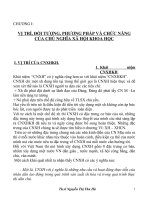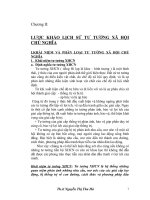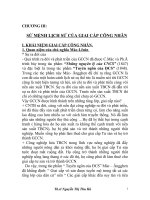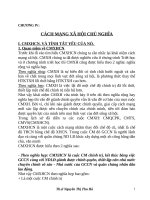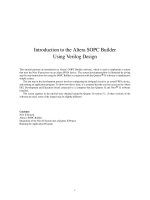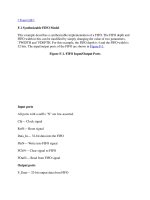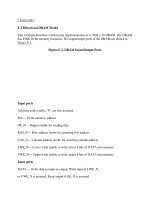FPGA prototyping using verilog examples (pong chu)
Bạn đang xem bản rút gọn của tài liệu. Xem và tải ngay bản đầy đủ của tài liệu tại đây (21.51 MB, 521 trang )
FPGA PROTOTYPING
BY VERILOG EXAMPLES
Xilinx SpartanTM-3Version
Pong P. Chu
Cleveland State University
WILEY
A JOHN WILEY & SONS, INC., PUBLICATION
This Page Intentionally Left Blank
FPGA PROTOTYPING
BY VERILOG EXAMPLES
This Page Intentionally Left Blank
FPGA PROTOTYPING
BY VERILOG EXAMPLES
Xilinx SpartanTM-3Version
Pong P. Chu
Cleveland State University
WILEY
A JOHN WILEY & SONS, INC., PUBLICATION
Copyright O 2008 by John Wiley & Sons, Inc. All rights reserved.
Published by John Wiley & Sons, Inc., Hoboken, New Jersey.
Published simultaneously in Canada.
No part of this publication may be reproduced, stored in a retrieval system, or transmitted in any form or by
any means, electronic, mechanical, photocopying, recording, scanning, or otherwise, except as permitted under
Section 107 or 108 of the 1976 United States Copyright Act, without either the prior written permission of the
Publisher, or authorization through payment of the appropriate per-copy fee to the Copyright Clearance Center,
Inc., 222 Rosewood Drive, Danvers, MA 01923, (978) 750-8400, fax (978) 750-4470, or on the web at
www.copyright.com. Requests to the Publisher for permission should be addressed to the Permissions
Department, John Wiley & Sons, Inc., 1l 1 River Sheet, Hoboken, NJ 07030, (201) 748-601 1, fax (201) 7486008, or online at http:1lwww.wiley.co1n/golpermission.
Limit of LiabilitylDisclaimer of Warranty: While the publisher and author have used their best efforts in
preparing this book, they make no representations or warranties with respect to the accuracy or completeness of
the contents of this book and specifically disclaim any implied warranties of merchantability or fitness for a
particular purpose. No warranty may be created or extended by sales representatives or written sales materials.
The advice and strategies contained herein may not be suitable for your situation. You should consult with a
professional where appropriate. Neither the publisher nor author shall be liable for any loss of profit or any
other commercial damages, including but not limited to special, incidental, consequential, or other damages.
For general information on our other products and services or for technical support, please contact our
Customer Care Department within the United States at (800) 762-2974, outside the United States at (3 17) 5723993 or fax (3 17) 572-4002.
Wiley also publishes its books in a variety of electronic formats. Some content that appears in print may not be
available in electronic format. For information about Wiley products, visit our web site at www.wiley.com.
Library of Congress Cataloging-in-Publication Data:
Chu, Pong P., 1959FPGA prototyping by Verilog examples 1 Pong P. Chu.
p. cm.
Includes index.
ISBN 978-0-470-18532-2 (cloth)
1. Field programmable gate arrays-Design and construction. 2. Prototypes,
Engineering. 3.Verilog (Computer hardware description language) I. Title.
TK7895.G36C484 2008
621.39'54~22
2008003732
Printed in the United States of America.
In memory of myfathel; Chia Chi Chu
This Page Intentionally Left Blank
CONTENTS
xxi
Preface
xxvii
Acknowledgments
PART I BASIC DIGITAL CIRCUITS
1 Gate-level combinational circuit
1.1
1.2
1.3
Introduction
General description
Basic lexical elements and data types
1.3.1 Lexical elements
1.4 Data types
1.4.1 Four-value system
1.4.2 Data type groups
1.4.3 Number representation
1.4.4 Operators
1.5 Program skeleton
1.5.1 Port declaration
1 S . 2 Program body
1.5.3 Signal declaration
1.5.4 Another example
1.6 Structural description
1.7 Testbench
1
1
2
3
3
4
4
4
5
5
5
6
7
7
8
9
12
vii
viii
CONTENTS
1.8
1.9
Bibliographic notes
Suggested experiments
1.9.1 Code for gate-level greater-than circuit
1.9.2 Code for gate-level binary decoder
2 Overview of FPGA and EDA software
2.1
2.2
2.3
2.4
2.5
2.6
2.7
2.8
2.9
Introduction
FPGA
2.2.1 Overview of a general FPGA device
2.2.2 Overview of the Xilinx Spartan3 devices
Overview of the Digilent S3 board
Development flow
Overview of the Xilinx ISE project navigator
Short tutorial on ISE project navigator
2.6.1 Create the design project and HDL codes
2.6.2 Create a testbench and perform the RTL simulation
2.6.3 Add a constraint file and synthesize and implement the code
2.6.4 Generate and download the configuration file to an FPGA device
Short tutorial on the ModelSim HDL simulator
Bibliographic notes
Suggested experiments
2.9.1 Gate-level greater-than circuit
2.9.2 Gate-level binary decoder
3 RT-level cornbinationaI circuit
3.1
3.2
3.3
Introduction
Operators
3.2.1 Arithmetic operators
3.2.2 Shifi operators
3.2.3 Relational and equality operators
3.2.4 Bitwise, reduction, and logical operators
3.2.5 Concatenation and replication operators
3.2.6 Conditional operators
3.2.7 Operator precedence
3.2.8 Expression bit-length adjustment
3.2.9 Synthesis of z and x values
Always block for a combinational circuit
3.3.1 Basic syntax and behavior
3.3.2 Procedural assignment
3.3.3 Variable data types
3.3.4 Simple examples
14
14
14
14
15
15
15
15
17
17
19
21
24
25
26
26
29
31
35
36
36
36
39
39
39
41
41
42
42
43
44
44
45
46
48
48
49
49
49
CONTENTS
3.4
If statement
3.4.1 Syntax
3.4.2 Examples
3.5 Case statement
3.5.1 Syntax
3.5.2 Examples
3.5.3 The casez and casex statements
3.5.4 The full case and parallel case
3.6 Routing structure of conditional control constructs
3.6.1 Priority routing network
3.6.2 Multiplexing network
3.7 General coding guidelines for an always block
3.7.1 Common errors in combinational circuit codes
3.7.2 Guidelines
3.8 Parameter and constant
3.8.1 Constant
3.8.2 Parameter
3.8.3 Use of parameters in Verilog-I995
3.9 Design examples
3.9.1 Hexadecimal digit to seven-segment LED decoder
3.9.2 Sign-magnitude adder
3.9.3 Barrel shifter
3.9.4 Simplified floating-point adder
3.10 Bibliographic notes
3.1 1 Suggested experiments
3.11.1 Multifunction barrel shifter
3.1 1.2 Dual-priority encoder
3.1 1.3 BCD incrementor
3.1 1.4 Floating-point greater-than circuit
3.1 1.5 Floating-point and signed integer conversion circuit
3.1 1.6 Enhanced floating-point adder
4 Regular Sequential Circuit
4.1
4.2
Introduction
4.1.1 D FF and register
4.1.2 Synchronous system
4.1.3 Code development
HDL code of the FF and register
4.2.1 D FF
4.2.2 Register
4.2.3 Register file
4.2.4 Storage components in a Spartan-3 device~Y"li""' p e c i f i c
ix
51
51
52
54
54
54
56
56
57
57
59
60
60
63
64
64
65
67
67
67
71
73
75
80
80
80
80
81
81
81
81
83
83
83
84
85
86
86
89
90
91
X
CONTENTS
4.3
4.4
4.5
4.6
4.7
Simple design examples
4.3.1 Shift register
4.3.2 Binary counter and variant
Testbench for sequential circuits
Case study
4.5.1 LED time-multiplexing circuit
4.5.2 Stopwatch
4.5.3 FIFO buffer
Bibliographic notes
Suggested experiments
4.7.1 Programmable square-wave generator
4.7.2 PWM and LED dimmer
4.7.3 Rotating square circuit
4.7.4 Heartbeat circuit
4.7.5 Rotating LED banner circuit
4.7.6 Enhanced stopwatch
4.7.7 Stack
119
5 FSM
5.1
5.2
5.3
5.4
5.5
91
91
93
96
99
99
107
110
115
115
115
115
116
116
116
116
117
Introduction
5.1.1 Mealy and Moore outputs
5.1.2 FSM representation
FSM code development
Design examples
5.3.1 Rising-edge detector
5.3.2 Debouncing circuit
5.3.3 Testing circuit
Bibliographic notes
Suggested experiments
5.5.1 Dual-edge detector
5.5.2 Alternative debouncing circuit
5.5.3 Parking lot occupancy counter
119
119
120
122
125
125
130
133
135
135
135
135
136
6 FSMD
139
6.1
139
139
140
141
143
144
146
6.2
Introduction
6.1.1 Single RT operation
6.1.2 ASMDchart
6.1.3 Decision box with a register
Code development of an FSMD
6.2.1 Debouncing circuit based on RT methodology
6.2.2 Code with explicit data path components
CONTENTS
6.3
6.4
6.5
6.2.3 Code with implicit data path components
6.2.4 Comparison
6.2.5 Testing circuit
Design examples
6.3.1 Fibonacci number circuit
6.3.2 Division circuit
6.3.3 Binary-to-BCD conversion circuit
6.3.4 Period counter
6.3.5 Accurate low-frequency counter
Bibliographic notes
Suggested experiments
6.5.1 Alternative debouncing circuit
6.5.2 BCD-to-binary conversion circuit
6.5.3 Fibonacci circuit with BCD I/O: design approach I
6.5.4 Fibonacci circuit with BCD I/O: design approach 2
6.5.5 Auto-scaled low-frequency counter
6.5.6 Reaction timer
6.5.7 Babbage difference engine emulation circuit
7 Selected Topics of Verilog
7.1
7.2
7.3
7.4
7.5
Blocking versus nonblocking assignment
7.1.1 Overview
7.1.2 Combinational circuit
7.1.3 Memory element
7.1.4 Sequential circuit with mixed blocking and nonblocking
assignments
Alternative coding style for sequential circuit
7.2.1 Binary counter
7.2.2 FSM
7.2.3 FSMD
7.2.4 Summary
Use of the signed data type
7.3.1 Overview
7.3.2 Signed number in Verilog-I995
7.3.3 Signed number in Verilog-2001
Use of function in synthesis
7.4.1 Overview
7.4.2 Examples
Additional constructs for testbench development
7.5.1 Always block and initial block
7.5.2 Procedural statements
7.5.3 Timing control
xi
148
i50
152
153
153
157
160
164
167
170
170
170
171
171
171
172
172
173
175
175
175
177
179
180
182
182
185
186
188
188
188
189
190
191
191
192
193
194
194
196
Xii
CONTENTS
7.6
7.7
7.5.4 Delay control
7.5.5 Event control
7.5.6 Wait statement
7.5.7 Timescale directive
7.5.8 System functions and tasks
7.5.9 User-defined functions and tasks
7.5.10 Example of a comprehensive testbench
Bibliographic notes
Suggested experiments
7.7.1 Shift register with blocking and nonblocking assignments
7.7.2 Alternative coding style for BCD counter
7.7.3 Alternative coding style for FIFO buffer
7.7.4 Alternative coding style for Fibonacci circuit
7.7.5 Dual-mode comparator
7.7.6 Enhanced binary counter monitor
7.7.7 Testbench for FIFO buffer
196
197
197
197
198
202
204
210
210
210
21 1
21 1
21 1
21 1
212
212
PART II 110MODULES
8 UART
8.1
8.2
8.3
8.4
8.5
8.6
8.7
Introduction
UART receiving subsystem
8.2.1 Oversampling procedure
8.2.2 Baud rate generator
8.2.3 UART receiver
8.2.4 Interface circuit
UART transmitting subsystem
Overall UART system
8.4.1 Complete UART core
8.4.2 UART verification configuration
Customizing a UART
Bibliographic notes
Suggested experiments
8.7.1 Full-featured UART
8.7.2 UART with an automatic baud rate detection circuit
8.7.3 UART with an automatic baud rate and parity detection circuit
8.7.4 UART-controlled stopwatch
8.7.5 UART-controlled rotating LED banner
9 PS2 Keyboard
9.1
9.2
Introduction
PS2 receiving subsystem
215
215
216
216
217
217
220
223
226
226
228
230
232
232
232
233
233
233
234
235
235
236
CONTENTS
9.3
9.4
9.5
9.6
9.2.1 Physical interface of a PS2 port
9.2.2 Device-to-host communication protocol
9.2.3 Design and code
PS2 keyboard scan code
9.3.1 Overview of the scan code
9.3.2 Scan code monitor circuit
PS2 keyboard interface circuit
9.4.1 Basic design and HDL code
9.4.2 Verification circuit
Bibliographic notes
Suggested experiments
9.6.1 Alternative keyboard interface I
9.6.2 Alternative keyboard interface I1
9.6.3 PS2 receiving subsystem with watchdog timer
9.6.4 Keyboard-controlled stopwatch
9.6.5 Keyboard-controlled rotating LED banner
10 PS2 Mouse
10.1 Introduction
10.2 PS2 mouse protocol
10.2.1 Basic operation
10.2.2 Basic initialization procedure
10.3 PS2 transmitting subsystem
10.3.1 Host-to-PS2-device communication protocol
10.3.2 Design and code
10.4 Bidirectional PS2 interface
10.4.1 Basic design and code
10.4.2 Verification circuit
10.5 PS2 mouse interface
10.5.1 Basic design
10.5.2 Testing circuit
10.6 Bibliographic notes
10.7 Suggested experiments
10.7.1 Keyboard control circuit
10.7.2 Enhanced mouse interface
10.7.3 Mouse-controlled seven-segment LED display
11 External SRAM
1 1.1 Introduction
1 1.2 Specification of the IS6 I LV25616AL SRAM
1 1.2.1 Block diagram and I/O signals
xiii
236
236
236
240
240
24 1
244
244
246
248
248
248
249
249
249
249
251
25 1
252
252
252
253
253
254
259
259
260
263
263
265
266
266
267
267
267
269
269
270
270
XiV
CONTENTS
1 1.2.2 Timing parameters
1 1.3 Basic memory controller
1 1.4
1 1.5
1 1.6
11.7
11.3.1 Block diagram
1 1.3.2 Timing requirement
1 1.3.3 Register file versus SRAM
A safe design
11.4.1 ASMD chart
1 1.4.2 Timing analysis
1 1.4.3 HDL implementation
1 1.4.4 Basic testing circuit
11.4.5 Comprehensive SRAM testing circuit
More aggressive design
11.5.1 Timing issues
1 1S . 2 Alternative design I
1 1 S.3 Alternative design I1
11S.4 Alternative design I11
1 1S.5 Advanced FPGA featuresXiLinZs p e c i f i c
Bibliographic notes
Suggested experiments
1 1.7.1 Memory with a 5 12K-by- 16 configuration
11.7.2 Memory with a 1M-by-8 configuration
11.7.3 Memory with an 8M-by-1 configuration
1 1.7.4 Expanded memory testing circuit
11.7.5 Memory controller and testing circuit for alternative design I
1 1.7.6 Memory controller and testing circuit for alternative design I1
1 1.7.7 Memory controller and testing circuit for alternative design I11
1 1.7.8 Memory controller with DCM
11.7.9 High-performance memory controller
12 Xilinx Spartan3 Specific Memory
12.1 Introduction
12.2 Embedded memory of Spartan-3 device
12.2.1 Overview
12.2.2 Comparison
12.3 Method to incorporate memory modules
12.3.1 Memory module via HDL component instantiation
12.3.2 Memory module via Core Generator
12.3.3 Memory module via HDL inference
12.4 HDL templates for memory inference
12.4.1 Single-port RAM
12.4.2 Dual-port RAM
12.4.3 ROM
270
274
274
275
276
276
276
277
278
28 1
283
288
288
288
290
291
293
294
294
294
295
295
295
295
295
295
295
296
297
297
297
297
298
298
299
299
300
300
300
303
305
CONTENTS
12.5 Bibliographic notes
12.6 Suggested experiments
12.6.1 Block-RAM-based FIFO
12.6.2 Block-RAM-based stack
12.6.3 ROM-based sign-magnitude adder
12.6.4 ROM-based sin(z) hnction
12.6.5 ROM-based sin(z) and C O S ( T ) functions
13 VGA controller I: graphic
13.1 Introduction
13.1.1 Basic operation of a CRT
13.1.2 VGA port of the S3 board
13.1.3 Video controller
13.2 VGA synchronization
13.2.1 Horizontal synchronization
13.2.2 Vertical synchronization
13.2.3 Timing calculation of VGA synchronization signals
13.2.4 HDL implementation
13.2.5 Testing circuit
13.3 Overview of the pixel generation circuit
13.4 Graphic generation with an object-mapped scheme
13.4.1 Rectangular objects
13.4.2 Non-rectangular object
13.4.3 Animated object
13.5 Graphic generation with a bit-mapped scheme
13.5.1 Dual-port RAM implementation
13.5.2 Single-port RAM implementation
13.6 Bibliographic notes
13.7 Suggested experiments
13.7.1 VGA test pattern generator
13.7.2 SVGA mode synchronization circuit
13.7.3 Visible screen adjustment circuit
13.7.4 Ball-in-a-box circuit
13.7.5 Two-balls-in-a-box circuit
13.7.6 Two-player pong game
13.7.7 Breakout game
13.7.8 Full-screen dot trace
13.7.9 Mouse pointer circuit
13.7.10 Small-screen mouse scribble circuit
13.7.1 1 Full-screen mouse scribble circuit
14 VGA controller II: text
XV
307
307
307
307
307
308
308
309
309
309
31 1
31 1
3 12
312
314
315
315
318
3 19
319
320
325
326
332
332
337
337
337
337
338
338
338
339
339
339
339
340
340
340
341
xvi
CONTENTS
14.1 Introduction
14.2 Text generation
14.2.1 Character as a tile
14.2.2 Font ROM
14.2.3 Basic text generation circuit
14.2.4 Font display circuit
14.2.5 Font scaling
14.3 Full-screen text display
14.4 The complete pong game
14.4.1 Text subsystem
14.4.2 Modified graphic subsystem
14.4.3 Auxiliary counters
14.4.4 Top-level system
14.5 Bibliographic notes
14.6 Suggested experiments
14.6.1 Rotating banner
14.6.2 Underline for the cursor
14.6.3 Dual-mode text display
14.6.4 Keyboard text entry
14.6.5 UART terminal
14.6.6 Square-wave display
14.6.7 Simple four-trace logic analyzer
14.6.8 Complete two-player pong game
14.6.9 Complete breakout game
34 1
34 1
34 1
342
344
345
347
348
352
352
358
359
36 1
366
366
366
366
366
366
366
367
367
368
368
PART 111 PICOBLAZE MICRO CONTROLLER^^^^^^
15 PicoBlaze Overview
15.1 Introduction
15.2 Customized hardware and customized software
15.2.1 From special-purpose FSMD to general-purpose microcontroller
15.2.2 Application of microcontroller
15.3 Overview of PicoBlaze
15.3.1 Basic organization
15.3.2 Top-level HDL modules
15.4 Development flow
15.5 Instruction set
15.5.1 Programming model
15.5.2 Instruction format
15.5.3 Logical instructions
15.5.4 Arithmetic instructions
15.5.5 ComDare and test instructions
371
37 1
372
372
374
374
374
376
377
377
379
379
380
381
3 82
CONTENTS
xvii
15.5.6 Shift and rotate instructions
15.5.7 Data movement instructions
15.5.8 Program flow control instructions
15.5.9 Interrupt related instructions
15.6 Assembler directives
15.6.1 The KCPSM3 directives
15.6.2 The PBlazeIDE directives
15.7 Bibliographic notes
383
384
386
389
390
390
390
391
16 PicoBlaze Assembly Code Development
393
16.1 Introduction
16.2 Useful code segments
16.2.1 KCPSM3 conventions
16.2.2 Bit manipulation
16.2.3 Multiple-byte manipulation
16.2.4 Control structure
16.3 Subroutine development
16.4 Program development
16.4.1 Demonstration example
16.4.2 Program documentation
16.5 Processing of the assembly code
16.5.1 Compiling with KCSPM3
16.5.2 Simulation by PBlazeIDE
16.5.3 Reloading code via the JTAG port
16.5.4 Compiling by PBlazeIDE
16.6 Syntheses with PicoBlaze
16.7 Bibliographic notes
16.8 Suggested experiments
16.8.1 Signed multiplication
16.8.2 Multi-byte multiplication
16.8.3 Barrel shift function
16.8.4 Reverse function
16.8.5 Binary-to-BCD conversion
16.8.6 BCD-to-binary conversion
16.8.7 Heartbeat circuit
16.8.8 Rotating LED circuit
16.8.9 Discrete LED dimmer
393
393
393
394
395
396
398
399
400
404
406
406
407
410
410
41 1
412
412
412
412
413
413
413
413
413
413
413
17 PicoBlaze 110 Interface
17.1 Introduction
17.2 Output port
415
415
416
XViii
CONTENTS
17.3
17.4
17.5
17.6
17.7
17.2.1 Output instruction and timing
17.2.2 Output interface
Input port
17.3.1 Input instruction and timing
17.3.2 Input interface
Square program with a switch and seven-segment LED display interface
17.4.1 Output interface
17.4.2 Input interface
17.4.3 Assembly code development
17.4.4 HDL code development
Square program with a combinational multiplier and UART console
17.5.1 Multiplier interface
17.5.2 UART interface
17.5.3 Assembly code development
17.5.4 HDL code development
Bibliographic notes
Suggested experiments
17.7.1 Low-frequency counter I
17.7.2 Low-frequency counter I1
17.7.3 Auto-scaled low-frequency counter
17.7.4 Basic reaction timer with a software timer
17.7.5 Basic reaction timer with a hardware timer
17.7.6 Enhanced reaction timer
17.7.7 Small-screen mouse scribble circuit
17.7.8 Full-screen mouse scribble circuit
17.7.9 Enhanced rotating banner
17.7.10 Pong game
17.7.1 1 Text editor
18 PicoBlaze Interrupt Interface
18.1 Introduction
18.2 Interrupt handling in PicoBlaze
18.2.1 Software processing
18.2.2 Timing
18.3 External interface
18.3.1 Single interrupt request
18.3.2 Multiple interrupt requests
18.4 Software development considerations
18.4.1 Interrupt as an alternative scheduling scheme
18.4.2 Development of an interrupt service routine
18.5 Design example
18.5.1 Interrupt interface
416
417
418
418
419
42 1
42 1
422
424
43 1
434
434
435
436
446
449
449
449
449
449
449
450
450
450
450
450
450
45 1
453
453
453
454
455
456
456
456
457
457
458
458
458
CONTENTS
18.5.2 Interrupt service routine development
18.5.3 Assembly code development
18.5.4 HDL code development
18.6 Bibliographic notes
18.7 Suggested experiments
18.7.1 Alternative timer interrupt service routine
18.7.2 Programmable timer
18.7.3 Set-button interrupt service routine
18.7.4 Interrupt interface with two requests
18.7.5 Four-request interrupt controller
Appendix A: Sample Verilog templates
A. 1 Numbers and operators
A. 1.1 Sized and unsized numbers
A. 1.2 Operators
A.2 General Verilog constructs
A.2.1 Overall code structure
A.2.2 Component instantiation
A.3 Routing with conditional operator and if and case statements
A.3.1 Conditional operator and if statement
A.3.2 Case statement
A.4 Combinational circuit using an always block
A.4.1 Always block without default output assignment
A.4.2 Always block with default output assignment
A S Memory Components
A.5.1 Register template
A.5.2 Register file
A.6 Regular sequential circuits
A. 7 FSM
A.8 FSMD
A.9 S3 board constraint file (s3.u c f )
xix
459
459
46 1
464
464
464
464
465
465
465
467
467
467
468
469
469
470
470
470
47 1
472
472
472
473
473
474
474
476
478
480
References
485
Topic Index
487
This Page Intentionally Left Blank
PREFACE
HDL (hardware description language) and FPGA (field-programmable gate array) devices
allow designers to quickly develop and simulate a sophisticated digital circuit, realize it
on a prototyping device, and verify operation of the physical implementation. As these
technologies mature, they have become mainstream practice. We can now use a PC and
an inexpensive FPGA prototyping board to construct a complex and sophisticated digital
system. This book uses a "learning by doing" approach and illustrates the FPGA and HDL
development and design process by a series of examples. A wide range of examples is
included, from a simple gate-level circuit to an embedded system with an 8-bit soft-core
microcontroller and customized 110 peripherals. All examples can be synthesized and
physically tested on a prototyping board.
Focus and audience
FOCUS The main focus of this book is on the effective derivation of hardware, not the
syntax of HDL. Instead of explaining every language construct, the book focuses on a
small synthesizable subset and uses about a dozen code templates to provide the skeletons
of various types of circuits. These templates are general and can easily be integrated to
construct a large, complex system. Although this approach limits the "freedom" of syntactic
expression, it will not prevent us from developing innovative hardware architecture. Because
of the generality and flexibility of HDL, the same circuit can usually be described by a
wide variety of language constructs and coding styles. Many of these codes are intended
for modeling. They may lead to unnecessarily complex hardware implementation and
sometimes cannot be synthesized at all. The template approach actually forces us to think
more about hardware and develop a good coding practice for synthesis. Since we are
xxii
PREFACE
more interested in hardware, it is more beneficial to spend time on developing 10 different
hardware architectures with the same code template rather than describing the same circuit
with 10 different versions of codes.
There are two popular HDLs, VHDL and Verilog. Both languages are used widely and
are IEEE standards. This book uses Verilog, and a separate book with a similar title uses
VHDL. Despite the drastic syntactic differences in the two languages, their capabilities are
very similar, particularly for our purposes. After we comprehend the design practice and
coding methodology in one language, learning the other language is rather straightforward.
Although the book is intended for beginning designers, the examples follow strict design
guidelines and prepare readers for future endeavors. The coding and design practice is
"forward compatible," which means that:
The same practice can be applied to large design in the future.
The same practice can aid other system development tasks, including simulation,
timing analysis, verification, and testing.
The same practice can be applied to ASIC technology and different types of FPGA
devices.
The code can be accepted by synthesis software from different vendors.
In summary, the book is a hands-on, hardware-centric text that involves minimal HDL
overhead and follows good design and coding practice to achieve maximal forward comparability.
perquisite
n.
Audience and perquisites The book contains three major parts: basic digital circuits,
peripheral modules, and embedded microcontroller. The intended audience is students in
an introductory or advanced digital system design course as well as practicing engineers
who wish to learn FPGA- and HDL-based development. For the materials in the first two
parts, readers need to have a basic knowledge of digital systems, usually a required course
in electrical engineering and computer engineering curricula. For the materials in the third
part, prior exposure to assembly language programming will be helpful.
logistics
n. ;
Logistics
neutral
n.
adj.
Although a major goal of this book is to teach readers to develop software-independent
and device-neutral HDL codes, we have to choose a software package and a prototyping
board to synthesize and implement the design examples. The synthesis software and FPGA
devices from Xilinx, a leading manufacture in this area, are used in the book.
Software The synthesis software used in the book is the Web version of the Xilinx
ISE package. The functionality of this version is similar to that of the full version but
supports only a limited number of devices. Most introductory development boards use
FPGA devices from the inexpensive Spartan-3 family. Since the Web version supports
the Spartan-3 device, it fits our needs. The simulation software used in the book is the
starter version of Mentor Graphics' ModelSim XE 111package. It is a customized edition
of ModelSim. Both software packages are free and can be downloaded from Xilinx's Web
site.
prototype
n.
FPGA prototyping board This book is prepared to be used with several entry-level
FPGA prototyping boards manufactured by Digilent Inc., including the Spartan-3 Starter,
Nexys-2, and Basys boards, all of which contain a Spartan-313E FPGA device and have
